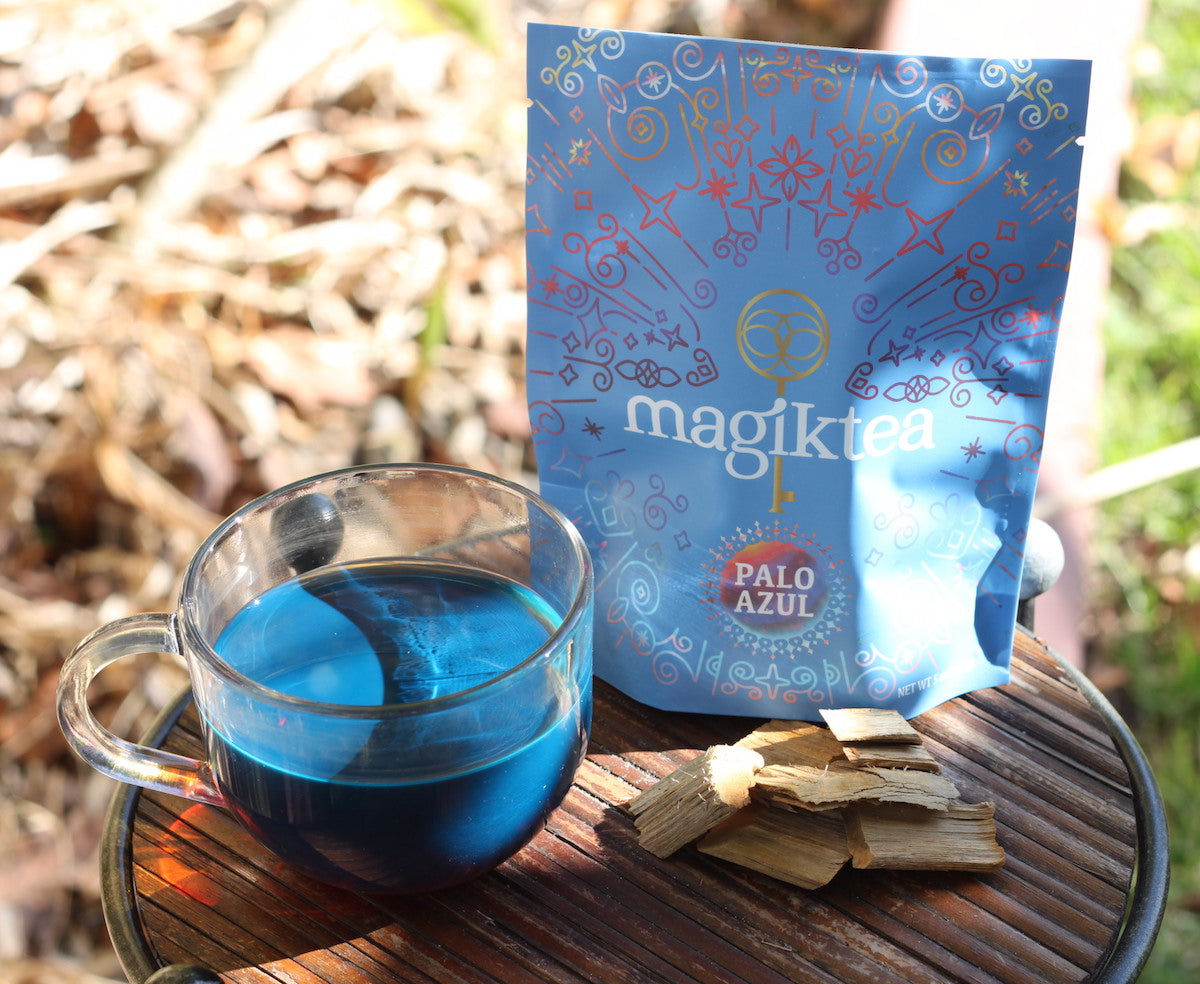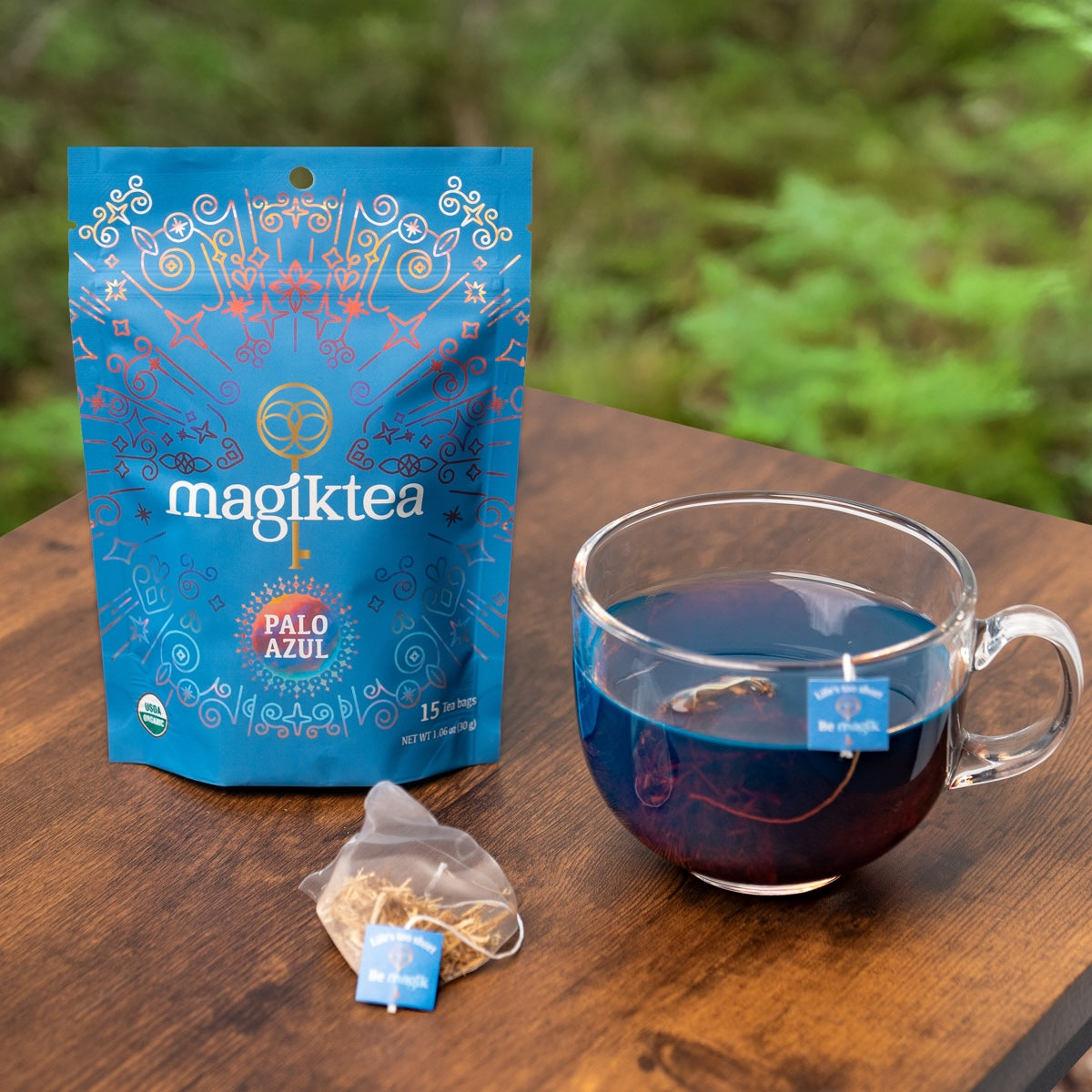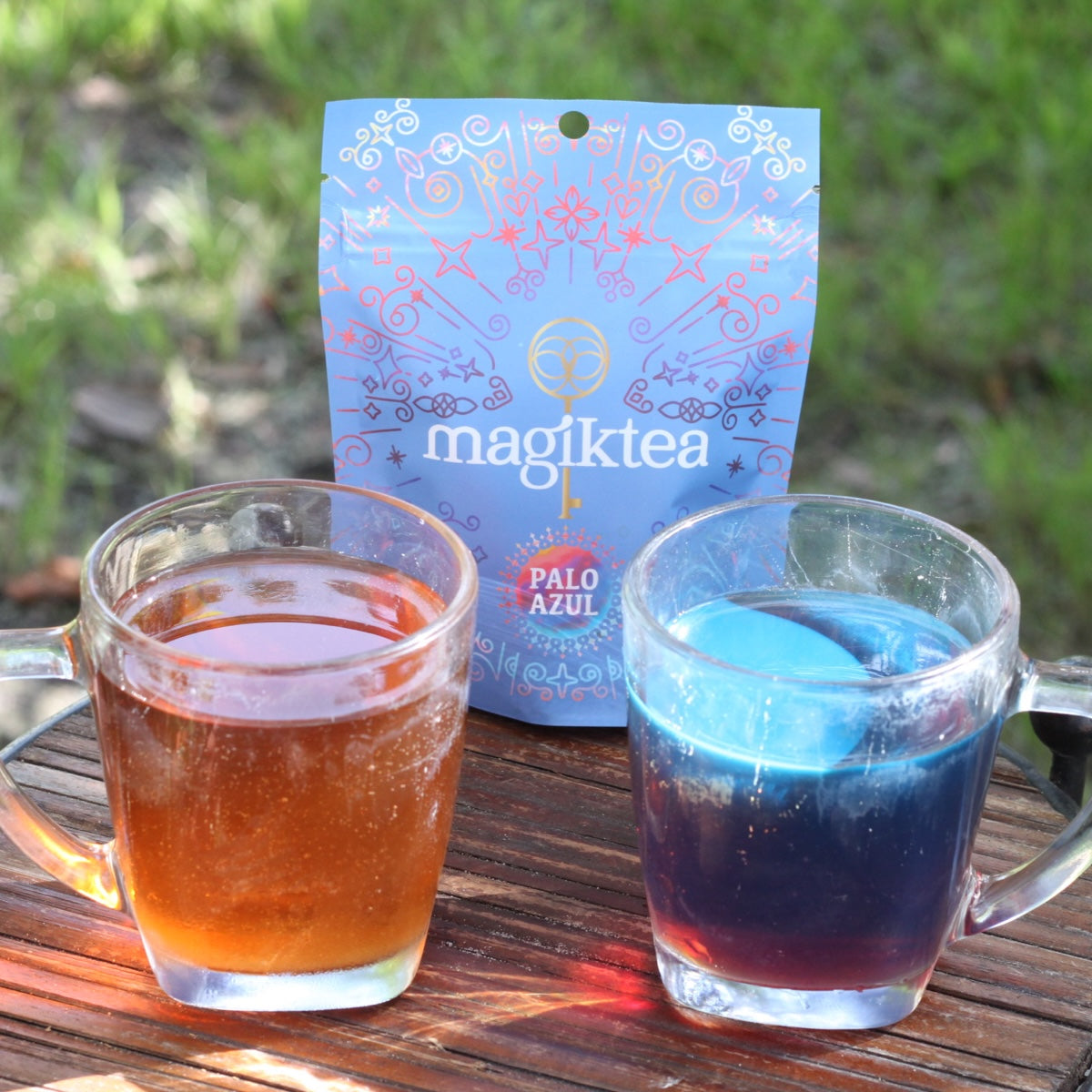Flavonoids are a family of polyphenolic compounds which are antioxidant, anti-inflammatory, anti-microbial, and much more. Many plants have flavonoids, including green tea, spirulina, coffee, cocoa, fruits and vegetables…but only a few plants have evolved the unique ability to produce fluorescent flavonoids. One of these plants is the palo azul tree, which releases its fluorescent flavonoids when the wood/bark is brewed with alkaline water and produces this celestial blue tea.
Why do plants produce flavonoids?

Numerous studies describe that plants produce flavonoids as a defense mechanism against environmental stressors such as UV light and other organisms. For example, this 2018 study mentions that the functions of flavonoids include "regulating plant development, pigmentation, and UV protection, to an array of roles in defence and signalling between plants and microorganisms."
This 2008 study also mentions that flavonoids are also “responsible for the bright colorations of many fruits and vegetables.” The researchers explain that “in addition to finding roles in protecting plants from UV irradiation, oxidative stress, toxic metals and fungal infections, flavonoids are able to attract symbiotic bacteria, suppress the growth of competing plants, selectively poison insects and deter herbivores.”
This 2010 study similarly concluded that “resveratrol protects the plant itself by reducing UV damage and eliminating pathogenic molds.”

Interestingly, this 2011 study describes that “many dietary phytochemicals that are synthesized as secondary metabolites function as toxins, that is, ‘phytoalexins,’ and hence protect plants against insects and other damaging organisms and stresses. However, at the relatively low doses consumed by humans and other mammals, these same toxic plant-derived chemicals, as mild stressors, activate adaptive cellular response signaling, conferring stress resistance and other health benefits. This phenomenon has been referred to as xenohormesis.”
What is Xenohormesis?

This 2010 study explains that “xenohormesis is a biological principle that explains how environmentally stressed plants produce bioactive compounds that can confer stress resistance and survival benefits to animals that consume them. This 2008 study describes that the term “xenohormesis” originated “from a combination of the prefix xeno-(for stranger) with hormesis (a protective response induced by mild stress).”
This 2004 study explains that the “xenohormesis hypothesis the idea that organisms have evolved to respond to stress signaling molecules produced by other species in their environment. In this way, organisms can prepare in advance for a deteriorating environment and/or loss of food supply.”
Humans Piggyback Off Plants' Defense Mechanisms

This 2010 study explains that “animals can piggyback off products of plants' sophisticated stress response which has evolved as a result of their stationary lifestyle. Factors eliciting the plant stress response can judiciously be employed to maximize yield of health-promoting plant compounds. The xenohormetic plant compounds can, when ingested, improve longevity and fitness by activating the animal's cellular stress response and can be applied in drug discovery, drug production, and nutritional enhancement of diet.”
It may not seem intuitive that the most stressed plants may be the most beneficial, but the researchers cite the example of “wine, where the best grapes in terms of taste and health benefit often result from relatively dry, sun-exposed, infertile soil.” They also mention that “resveratrol, a polyphenol, is stimulated by UV light, ozone, or pathogen stress.” Because of the increased production of polyphenols, they cite this study which found that “drought-stressed strawberries have better taste, antioxidant capacity, and phenol content.”
Stressed Plants Develop More Nutrients & Color

One of the authors of the previously cited 2008 study, David Sinclair, wrote a book titled Lifespan: Why We Age and Why We Don't Have To, in which he writes the following:
“[We were] fascinated by the fact that resveratrol is produced in greater quantities by grapes and other plants experiencing stress. We also knew that many other health-promoting molecules, and chemical derivatives of them, are produced in abundance by stressed plants. This, we believe, is evidence of xenohormesis—the idea that stressed plants produce chemicals for themselves that tell their cells to hunker down and survive. Plants have survival circuits, too, and we think we might have evolved to sense the chemicals they produce in times of stress as an early-warning system, of sorts, to alert our bodies to hunker down as well.
What this means, if it’s true, is that when we search for new drugs from the natural world we should be searching the stressed-out ones: In stressed plants, in stressed fungi, and even in the stressed microbiome populations in our guts. The theory is also relevant to the foods we eat; plants that are stressed have higher concentrations of xenohormetic molecules that may help us engage our own survival circuits. Look for the most highly colored ones because xenohormetic molecules are often yellow, red, orange, or blue.”

Studies Show Palo Azul Has 8x More Antioxidants Than Green Tea
In other words, stressed plants produce more polyphenols as a survival mechanism and these polyphenols are responsible for their bright colors. This is why Dr. Sinclair reccommends looking for the most colorful plants, because they'll have the highest amount of polyphenols. This is probably the reason why palo azul evolved to produce a much brighter color than green tea, and thus, a much higher polyphenolic content.
How do Xenohormetic Molecules Benefit humans?

This 2008 study found that “polyphenols such as resveratrol and quercetin, which are produced by stressed plants, activate sirtuin enzymes and extend the lifespan of fungi and animals, ostensibly by mimicking the beneficial effects of caloric restriction.”
This 2004 study which corroborates the previous study, found that “CR (caloric restriction) extends lifespan because it is a mild biological stressor that activates Sir2, a key component of yeast longevity.” They mention that “a class of polyphenolic molecules produced by plants in response to stress can activate the sirtuins” and they concluded that “at least in the case of yeast, these molecules greatly extend lifespan by mimicking CR.”

Additionally, this 2022 study found that “polyphenol-induced anti-inflammatory protective effects are mediated in large part via the activation of AMPK and the upregulation of Nrf2 pathway.” The researchers conclude that consuming polyphenols “at low concentration according to the hormesis theory activates this neuroprotective cascade to preserve brain health and its potential use in the prevention and therapy against aging.”
Other examples of hormesis

The prefix “xeno” is applied to the term “hormesis” to describe this adaptive mechanism from consuming exogenous plant polyphenols, but our bodies are also capable of producing endogenous hormesis (within our body). The principal methods of hormesis are exercise, fasting, heat, and cold. This 2019 study mentions that “mild environmental stress might have beneficial effects in aging by activating maintenance and repair processes in cells and organs.”
1. Exercise

There are plenty of studies which show the beneficial effect of muscular adaptations caused by inducing mild stress through exercise. The key word being, “mild”, because excessive stress to the muscles has actually shown to be deleterious. Below we provide some references:
This 2020 study showed that “regular aerobic exercise has numerous benefits on human physiology, arguably by serving as a hormetic stressor resulting in positive adaptations over time.”
This 2015 study showed that “regular moderate training appears beneficial for oxidative stress and health. Conversely, acute exercise leads to increased oxidative stress, although this same stimulus is necessary to allow an up-regulation in endogenous antioxidant defenses (hormesis).”

This 2016 study further elaborates that ”skeletal muscle shows considerable plasticity and adaptions in response to a single bout of acute exercise or chronic training, especially in antioxidant defense capacity and metabolic functions mainly due to remodeling of mitochondria. It has thus been hypothesized that contraction-induced production of reactive oxygen species (ROS) may stimulate the hormesis-like adaptations.”
This 2008 study similarly showed that “mechanical damage-mediated adaptation results in increased muscle mass and increased resistance to stressors.” However, this study also showed that “excessive exercise and overtraining lead to damaging oxidative stress."
2. Fasting

When we fast and/or restrict carbohydrates as in the newly popularized intermittent fasting and ketogenic diets, our body adapts to burn fat for energy. This metabolic state where the body burns fat for energy instead of carbohydrates is called ketosis. The name "ketosis" is derived from the ketone molecules that our liver produces when it burns fat for energy.
This 2021 study throughly explains how ketone metabolism is a beneficial hormetic stressor:
“Oxidative stress induced by ketone body metabolism is beneficial in the long term because it initiates an adaptive (hormetic) response characterized by the activation of the master regulators of cell-protective mechanism, nuclear factor erythroid 2-related factor 2 (Nrf2), sirtuins, and AMP-activated kinase. This results in resolving oxidative stress, by the upregulation of anti-oxidative and anti-inflammatory activities, improved mitochondrial function and growth, DNA repair, and autophagy.
We conclude that the increased synthesis and use of ketone bodies as ancillary fuel during periods of deficient food supply and low insulin levels causes oxidative stress in the mitochondria and that the latter initiates a protective (hormetic) response which allows cells to cope with increased oxidative stress and lower energy availability.”

In layman’s terms…ketone metabolism activates beneficial processes in the body which help to burn fat for energy.
“Nrf2 is activated by regular exercise and plays an important role in exercise-induced cardiovascular benefits such as increased mitochondrial biogenesis and capacity, physiologic remodeling of the heart muscle, and reduced arteriosclerosis.”
“Sirtuins are associated with the delay of age-related diseases and, in some cases, increased longevity. Activation of sirtuins or nicotinamide adenine dinucleotide repletion induces angiogenesis, insulin sensitivity, and other health benefits in a wide range of age-related cardiovascular and metabolic disease models.”
“AMPkinase is an enzyme that plays a role in cellular energy homeostasis, largely to activate glucose and fatty acid uptake and oxidation when cellular energy is low. When activated, AMPK stimulates energy generating processes such as glucose uptake and fatty acid oxidation and decreases energy consuming processes such as protein and lipid synthesis.”
3. Heat

Many studies have shown the plethora of benefits that one can get from heat exposure from saunas and steam rooms. Heat activates the stress response pathway in our body which produces heat shock proteins.
This 2020 study explains that “heat-shock proteins” constitute the first line of protection for cells exposed to stressful conditions. They participate to the safeguard of cell integrity, keeping functional signaling pathways critical for cell survival and normal cell function.”
Due to the beneficial effects of these heat shock proteins, this 2021 review on the health benefits of saunas concludes the following:
“Repeated sauna use acclimates the body to heat and optimizes the body's response to future exposures, likely due to the biological phenomenon known as hormesis. In recent decades, sauna bathing has emerged as a probable means to extend healthspan, based on compelling data from observational, interventional, and mechanistic studies. Of particular interest are the findings from large, prospective, population-based cohort studies of health outcomes among sauna users that identified strong dose-dependent links between sauna use and reduced morbidity and mortality.”

This 2018 study similarly concluded that “the human body can adapt relatively well to heat and cold environments, and recent studies have also elucidated that particularly heat stress might be even highly beneficial for human health. Plausible mechanisms included are improved endothelial and microvascular function, reduced blood pressure and arterial stiffness, and possibly increased angiogenesis in humans, which are likely to mediate the health benefits of sauna bathing.”
4. Cold

Counterintuitively, it has been shown that cold exposure also activates heat shock proteins, albeit at a lower degree than heat. This 1993 study found that “clearly, cold shock stimulates a stress response in human epidermis altering the spectrum of proteins expressed and inducing the synthesis of heat shock proteins.”
This 2021 study explains how cold shock proteins can be beneficial for humans: “Cold exposure can increase energy expenditure and whole body glucose and fatty acid utilization. Repeated exposures can lower fasting glucose and insulin levels and improve dietary fatty acid handling.”
This 2016 study further elaborates on the benefits of cold immersion:
"A basic property of endothermic thermoregulation is the ability to generate heat by increasing metabolism in response to cold ambient temperatures to maintain a stable core body temperature. This process, known as cold-induced thermogenesis (CIT), has been measured in humans as early as 1780 by Antoine Lavoisier, but has found renewed interest because of the recent 'rediscovery' of thermogenic, cold-activated brown adipose tissue (BAT) in adult humans. There has been a substantial range of variability in the reported CIT in these studies, from 0 to 280% above basal metabolism.”

This 2012 study explains that “brown adipose tissue has a high concentration of mitochondria and uniquely expresses uncoupling protein 1, enabling it to be specialized for energy expenditure and thermogenesis.” As opposed to white adipose tissue, which is “specialized for energy storage.”
This 2021 Harvard article similarly states that ”brown fat, or brown adipose tissue, is a distinct type of fat that is activated in response to cold temperatures. Its primary role is to produce heat to help maintain body temperature, and it achieves that by burning calories.”
Conclusion

This astoundingly clever mechanism of hormesis was first discovered by Hugo Schulz in the 19th century when he noticed that small doses of toxic compounds would enhance the growth of yeast. He discovered that small doses of toxins would yield an adaptive response which not only mitigated the harmful toxins, but would actually improve growth and stress resistance. Yet, too high a dose would be detrimental.
It’s truly remarkable that the aphorism famously stated by Neitzsche, “what doesn’t kill you makes you stronger”, is so apparent in all of nature. Even more remarkable is the mere fact that not only do our bodies benefit from mild environmental stressors such as exercise, fasting, heat or cold…but also from the polyphenols found in plants which they themselves evolved to produce in their own evolutionary journey to adapt and survive. And because of this intricate adaptive mechanism for overcoming stress, plants such as palo azul developed these fluorescent flavonoids which are not only magical to see, but so magical to our health as well.
Sources
Lifespan: Why We Age and Why We Don’t Have To
(2010) Xenohormesis: health benefits from an eon of plant stress response evolution
(2011) Xenohormesis mechanisms underlying chemopreventive effects of some dietary phytochemicals
(2022) Xenohormesis underlyes the anti-aging and healthy properties of olive polyphenols
(2004) Small molecules that regulate lifespan: evidence for xenohormesis
(2019) Toxin-induced hormesis may restrain aging
(2018) Flavonoid Functions in Plants and Their Interactions with Other Organisms
(2020) Exercise and intestinal permeability: another form of exercise-induced hormesis?
(2016) Exercise-induced hormesis and skeletal muscle health
(2015) Exercise and oxidative stress: potential effects of antioxidant dietary strategies in sports
(2008) Exercise, oxidative stress and hormesis
(2021) Ketone bodies: from enemy to friend and guardian angel
(2016) Hormesis running hot and cold
(2022) Health effects of voluntary exposure to cold water - a continuing subject of debate
(2020) Heat-shock proteins: chaperoning DNA repair
(2021) Sauna use as a lifestyle practice to extend healthspan
(2018) Effects of heat and cold on health, with special reference to Finnish sauna bathing
(1993) Cold shock induces the synthesis of stress proteins in human keratinocytes
(2016) Cold-induced thermogenesis in humans







